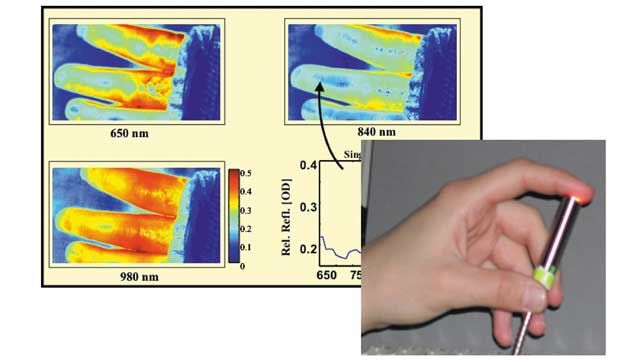Canada's Institute for Biodiagnostics Develops an Imaging Tool for Assessing Burn Injuries
"MathWorks tools allowed us to thoroughly explore our data, understand it, and put together an optimal data analysis approach."
Challenge
Solution
Results
- Effective, noninvasive tool for assessing burns
- Flexible test environment
- Accelerated algorithm development process

Doctors typically assess the depth and severity of a burn injury based on the visual appearance of the wound when the patient is first admitted to the hospital. This method often fails to provide an accurate picture, as certain burn injuries worsen over time. Even sophisticated techniques, such as ultrasound and thermography, cannot ensure appropriate diagnosis. As a result, by the time treatment has been determined, the tissue may be damaged irreversibly.
Researchers at the Institute for Biodiagnostics, a division of Canada's National Research Council, have developed a tool that enables doctors to detect and treat threatened tissue while there is still time to save it. The tool uses near-infrared (NIR) spectroscopy and imaging to monitor variations in skin hemodynamics (oxygen utilization and blood volume) at the site of the wound. The researchers used MathWorks tools to analyze their data and experiment with algorithmic approaches.
"MathWorks products allowed us to explore a lot of data analysis options with little effort," says Dr. Lorenzo Leonardi, Principal Investigator on the project.
Challenge
Dr. Leonardi’s research team, which consisted of Michael Sowa, Bernhard Schattka, Trevor Posthumous, Michelle Hastings, and Jeri Payette, set out to develop a reliable, objective, and easy-to use-technique for evaluating burn injuries as soon as possible after the injury occurred. They knew that burn injuries change the hemodynamics of the skin. They also knew that burns of differing degrees have different hemodynamic responses in the post-burn stage. They needed a way to evaluate tissue hemodynamics in the early post-burn period.
To gain a clearer picture, they decided to investigate the epidermis and the deep dermis using an NIR spectroscope. NIR light can penetrate tissue more deeply than visible wavelengths, detecting changes in tissue status before they can be seen with the naked eye.
The researchers would have to try out several NIR light collection, analysis, and visualization methods. They would require a flexible software environment in which to model and simulate concepts and evaluate a range of algorithms.
Solution
They began by investigating what burn injuries do to the skin. Hemoglobin is a marker of the amount of oxygen within the tissue and can be “seen” with NIR light. They therefore measured hemoglobin levels as well as tissue blood volume.
Two data collection devices were used: a point spectrometer with a multifiber probe and a high-density CCD camera. The spectrometer illuminated the tissue in the region of interest and collected re-emitted light. The CCD camera and a wavelength selector let them acquire images of the burn tissue at different wavelengths. This spectral information helped them determine if the tissue was well oxygenated and supplied with blood.
MathWorks products helped them manage potentially unwieldy data. For example, when the CCD images provided more spatial resolution than they needed, they used wavelet compression and decomposition methods in Wavelet Toolbox to decompose or compress the data.
Working in MATLAB, they ran simulations of how the burn injury might affect the epidermis and the deep dermis. They then used Signal Processing Toolbox and Image Processing Toolbox to rapidly develop different algorithmic approaches to collecting and analyzing the spectral images.
The image registration functions in Image Processing Toolbox let them correct images that had been misaligned by slight movements of the patient. “Image registration is critical for our applications because we need to make sure that images aren’t distorted when the patient moves and breathes,” Leonardi explains.
Clinical trials are under way at Sunnybrook Hospital, Toronto, the largest burn center in Canada, where surgeons are using the imaging tool to classify burn injuries. Results so far are promising, and NRC plans to apply for FDA approval to develop a commercial version of the product.
Results
Effective, noninvasive tool for assessing burns. Dr. Leonardi and his team demonstrated that NIR spectroscopy can reliably determine oxygen saturation and changes in blood volume deep within injured tissue. Their diagnostic tool enables clinicians to distinguish between burns of varying severity and determine appropriate treatment early enough to prevent irreversible tissue damage.
Flexible test environment. MATLAB and the toolboxes made it easy to test and modify algorithms. For example, when a least squares fitting approach to analyzing data collected by the spectrometer and CCD camera produced unrealistic results, the researchers used Optimization Toolbox to switch to linear programming. “We were up and running again within a couple of days,” Leonardi says. “To write that program from scratch would have taken a lot more time.”
Accelerated algorithm development process. We couldn’t live without Signal Processing Toolbox and Image Processing Toolbox,” says Leonardi. “To program our algorithms from square one would cost us a lot of time, effort, and energy. The toolboxes have really speeded up what we can do.”